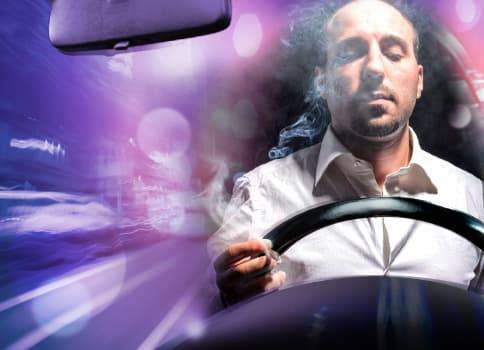Legalized Marijuana Makes Drugged-Driving Study High Priority


Whether you think the grass is always greener on the side where weed is allowed or fear the whole country will go to pot, legalized recreational marijuana has taken root in the U.S. As it spreads to more states, questions about what a legalized America will look like abound, many of which will only be answered through trial, error and experience. One such issue — how to handle the projected increase in “drugged driving” — is about as hazy as a ’90s college dorm room littered with black-light posters and Phish CDs.
Planned Safety Tech Would Prevent Drunken Drivers From Starting Car
Two states already have legalized the recreational use of marijuana — Colorado and Washington — and more than a dozen states are poised to follow suit by 2016. That’s in addition to 22 states and the District of Columbia, where the drug already has been OK’d for medical purposes or decriminalized.
According to anti-drunken-driving advocacy group Mothers Against Drunk Driving, alcohol-related driving deaths have declined by half since 1980, but drunken-driving accidents cost the U.S. about $132 billion a year. What’s worse, on average 1 in 3 people will be involved in an alcohol-related crash in their lifetime and every day 28 people die in drunken-driving accidents. How will marijuana-related driving accidents impact these numbers?

It’s difficult to quantify the direct role marijuana plays in car crashes, and apples-to-apples comparisons to alcohol aren’t available. As Insurance.com notes, “many accidents are caused by people using marijuana in conjunction with other drugs, or in combination with alcohol.” Still, a National Highway Traffic Safety Administration study found that 4 percent of drivers were high during the day and more than 6 percent at night, and that nighttime figure more than doubled on weekends. Moreover, Columbia University researchers performing a toxicology examination of nearly 24,000 driving fatalities concluded that marijuana contributed to 12 percent of traffic deaths in 2010, tripled from a decade earlier.
NHTSA studies have found drugged driving to be particularly prevalent among younger motorists. One in eight high school seniors responding to a 2010 survey admitted to driving after smoking marijuana. Nearly a quarter of drivers killed in drug-related car crashes were younger than 25. Likewise, nearly half of fatally injured drivers who tested positive for marijuana were younger than 25.
But people are and have been smoking marijuana, regardless of its legal status, so will incentives such as increased ease of access, decreased risk of trouble with the law and a destigmatizing of the drug’s users translate to more people stoned behind the wheel? No one knows that for sure, but Colorado has seen a spike in driving fatalities in which marijuana alone was involved, according to Insurance.com. The trend started in 2009 — the year medical marijuana dispensaries were effectively legalized at the state level, starting the so-called Green Rush there — and remained stable through 2013, the year after recreational prohibition ended in Colorado.
To combat what it calls “the growing problem of drugged driving,” the federal Office of National Drug Control Policy’s National Drug Control Strategy includes a goal of reducing drugged driving by 10 percent by making prevention a “national priority on par with preventing drunk driving.” The strategy calls for:
- Encouraging states to adopt “per se” laws prohibiting any trace of the drug in a driver’s system while in control of a vehicle, even absent other evidence of impairment
- Collecting further data on drugged driving
- Public education
- Law-enforcement training for identifying drugged drivers
- Standardized screening methods for drug-testing labs for use in detecting the presence of drugs
Complicating matters of crafting and enforcing drugged-driving laws is limited study of the effects of smoking marijuana specifically on operating a motor vehicle. Soon that won’t be the case. NHTSA and the National Institute on Drug Abuse are now in the final months of a three-year, half-million-dollar cooperative study to determine the impact of inhaled marijuana on driving performance. Tests observe participants who ingest a low dose of THC (the active drug in marijuana), a high dose and a placebo to assess the effects on performance, decision-making, motor control, risk-taking behavior and divided-attention tasks.
The study is being performed using what NHTSA calls “the world’s most advanced driving simulator,” the University of Iowa’s National Advanced Driving Simulator, which was previously used to study the effects of alcohol on driving. It’s the first time NADS is being used to study the effects of an illicit substance, though researchers hope it will help clear the air on the marijuana issue.
“The mixed results from previous cannabis-dosed driving studies have demonstrated that its effects on driving can be more difficult to detect than the effects of alcohol,” NHTSA stated. “The NADS, a more sensitive data collection tool, is capable of detecting the more subtle changes in driving behavior of cannabis-dosed participants.”
From a law-enforcement perspective, aside from garden-variety physical signs that a motorist is intoxicated it’s difficult for an officer to determine on the spot whether someone has specifically used marijuana, and no reliable Breathalyzer-style test for the drug yet exists. Still, the law doesn’t distinguish between drunk and drugged, and substance-impaired drivers can still be charged with driving under the influence.
“A DUI is a DUI,” Insurance.com says, “and toxic to a driving record and car insurance rates either way.”
Cars.com photo illustration by Paul Dolan; photos by Dario Lo Presti/iStock/Thinkstock, Chad Baker/Jason Reed/Ryan McVay/Photodisc/Thinkstock, defun/iStock/Thinkstock and itayuri/iStock/Thinkstock

Former Assistant Managing Editor-News Matt Schmitz is a veteran Chicago journalist indulging his curiosity for all things auto while helping to inform car shoppers.
Featured stories




